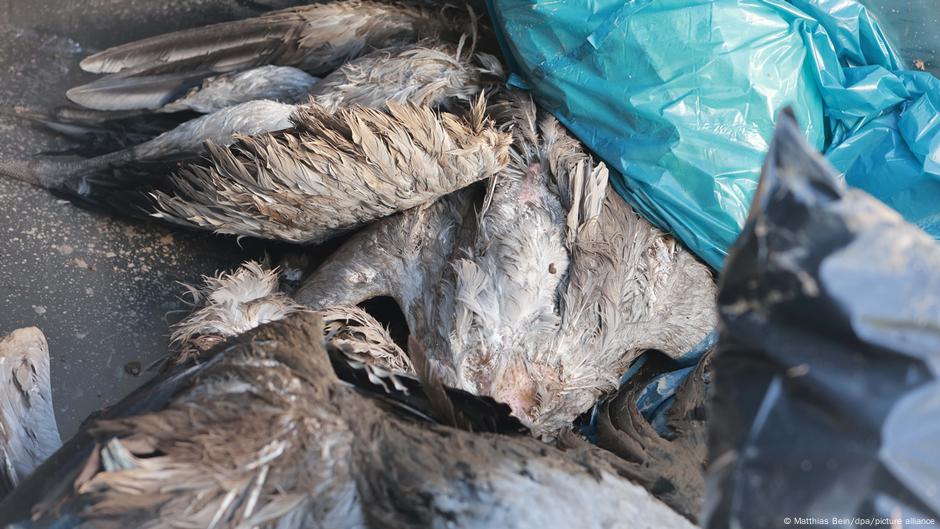Bird flu cases are rising in the Northern Hemisphere, and outbreaks are likely to continue testing farmers and public health authorities determined to curb the spread this winter.
The current circulating “clade” of H5N1, which is mainly carried by birds, is highly pathogenic, meaning it can cause severe avian influenza (or bird flu).
Though H5N1 was first detected in the mid-1990s, it has only been since 2020 that outbreaks have occurred annually.
H5N1 is now present on every continent, including Antarctica, and continues to concern health authorities, disease scientists and wildlife specialists.
In Germany, major farm culls — as well as thousands of livestock — have taken place to prevent the spreading further.
Denmark and the Netherlands have taken similar action to remove thousands of infected , and nearby countries, such as Belgium and France, have been forced to take protective action to prevent farm stock becoming exposed.
Why are bird flu cases increasing now?
It is fall in the Northern Hemisphere, so migratory bird populations are beginning their annual journeys to warmer climates in the Southern Hemisphere.
Because flocks make stopovers to rest on their long journeys, they come into contact with other local, wild and farm birds.
But these bird migrations started earlier this year, and more species — such as migratory cranes — have been infected with the H5N1 disease. This has led to an increase in the chance of poultry becoming infected, especially when sick birds die nearby.
“Previously, bird flu was only to be expected in winter, but now there are cases all year round, at least in wild birds,” said Ursula Höfle, a veterinary scientist at the University of Castilla-La Mancha, Spain.
The risk of wild and domestic animals being in close contact with each other has been shown most recently in Germany. Infected cranes have perished on their southward journey near the capital Berlin, in the country’s east, and Stuttgart, a city in the southwest. To stem the transmission, farms have been forced to conduct mass culls and dispose of half-a-million poultry birds.
The Friedrich Loeffler Institute (FLI), Germany’s federal agency responsible for animal health research, expects more infections and transmissions into November.
Farms in the Netherlands have also culled tens of thousands of birds, while France and Belgium, have raised their alert levels to “high”, forcing poultry to now be kept indoors. Cases have also been detected in the UK and Slovakia.
H5N1: A zoonotic disease that jumps from animals to humans
including ones that cause bird flu, often infect more than their host species. They are constantly circulating in animal populations, including humans, horses, pigs, bats, and birds.
When it comes to H5N1, it is very easy for carrier birds to transmit infections to others. Usually, this occurs by direct exposure to the carrier, inhalation of viral particles in the air, or contact with contaminated surfaces. H5N1 particles can be “shed” in a bird’s saliva, body fluids, and feces.
Such transmission routes make it possible for poultry to become infected by wild birds. Other farm animals and humans can then catch the virus by close exposure to an infected bird. Farm workers are being reminded to wear protective clothing to avoid infection.
“In addition to a protective suit, this also includes disposable gloves, safety goggles and an FFP3 respirator,” said Timm Harder, a viral diagnostics laboratory manager at the FLI.
Some people — mainly agricultural workers — have been infected with H5N1 in recent years; most have survived, and none have passed the infection onto others.
This is crucial. A major fear is that this variety of bird flu could eventually undergo enough genetic modifications to spread between people, potentially leading to another
“The more times this virus has an opportunity to infect a human, to infect an animal, the more chances it has — if there is a shift in the genetics that makes it easier — for it to transmit human-to-human,” said Meghan Davis, an environmental health researcher at Johns Hopkins Bloomberg School of Public Health.
The pandemic question: Could bird flu spread between humans?
There remains a low, but real, risk that the H5N1 virus could evolve to spread from humans to humans.
Currently, only close and repeated exposure to infected animals is known to heighten the risk of a person catching the disease.
“The H5N1 viruses […] which are dominant in Europe and the US, are estimated by the ECDC [European Centre for Disease Prevention and Control] to be low zoonotic,” said Harder.
Risk also lies . Authorities warn against consuming raw food, especially raw milk and related products, as these can contain influenza virus particles.
In 2024, the state of California took precautionary measures against the consumption of raw milk products that have not been pasteurized to remove pathogens.
Food production likely to be hit as outbreaks increase
“It’s always devastating to see a resurgence of highly pathogenic avian influenza, especially in poultry,” said Kristen Coleman, an airborne infectious disease researcher at the University of Maryland, US.
Farmers are likely to report and meat products in areas affected by large-scale culling, resulting in price increases for consumers.
“It’s definitely having an impact on our food supply,” said Coleman, adding that American consumers would feel the pinch around Thanksgiving in November if turkeys are in shorter supply.
But Coleman said culling is often the best approach to managing bird flu outbreaks. It can prevent the disease from spreading to other farms, wild bird populations and other mammals.
An H5N1 outbreak in 2023 in Argentina spread to more than 24,000 sealions across the Pacific and Atlantic coasts of South America and wiped them out.
Edited by: Zulfikar Abbany
The post Disease in flight: Bird flu spreads in Europe, US. What’s new? appeared first on Deutsche Welle.




